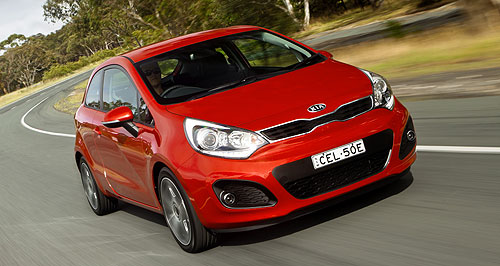Kia Rio set to go turbo
BY BYRON MATHIOUDAKIS | 11th Mar 2013

Due to coincide with more stringent carbon dioxide emission requirements from 2015, Kia with parent Hyundai is developing 1.0-litre and 1.2-litre three-cylinder petrol Kappa family units with and without turbo-chargers.
They follow on from the U-series 1.1-litre three-cylinder and 1.4, 1.5, and 1.6-litre turbo-diesel units released over the last four years.
According to Dr Joachim Hahn, head of drivetrain engineering for Kia in Europe, there will be upwards of 100 horsepower (about 75kW) on offer, in vehicles that must be lighter and more efficient than today’s range.
Advancements in direct-injection technology, as well as more efficient turbos, are ensuring that there are no compromises as far as buyer performance expectations are concerned.
However the senior Kia engineer stopped short of confirming three-cylinder petrol engines for the larger Cerato and Cee’d sized C-segment vehicles of the future.
“For the B-segment next-generation, we are thinking of more-sophisticated technology, especially turbo-charging,” he told GoAuto at the Geneva motor show this week.
“We are convinced that all the mainstream powertrains all be smaller engines… 1.0 and 1.2-litres – these are the displacement classes where the work has to be done… and with turbos.”Though Dr Hahn said he wasn’t prepared to nominate an exact arrival date, he did suggest that the current Rio’s successor due in 2016 would be a good indication.
“It’s something we should think about the next-generation (Rio),” he said.
Meanwhile, a downsized 1.2-litre four-cylinder turbo petrol engine is set to replace the 1.6-litre units in higher-specified Rios and Ceratos/Cee’ds.
It will sit below the Cee’d/Pro_cee’d GT’s 1.6-litre turbo petrol Gamma powerplant that will shortly be further developed beyond today’s 150kW as the Hyundai group’s small-car performance base (see separate story).
“We have already communicated that this (1.2-litre four-cylinder turbo petrol) engine will have about 100kW,” Dr Hahn said.
“I think there are segments of customers who want that sort of power, and maybe have demand for higher levels of reduced NVH (noise, vibration and harshness).”The next phase of Europe’s emissions standards calls for a fleet average of 130g/km of CO2 from 2015, and just 90g/km from 2020.

